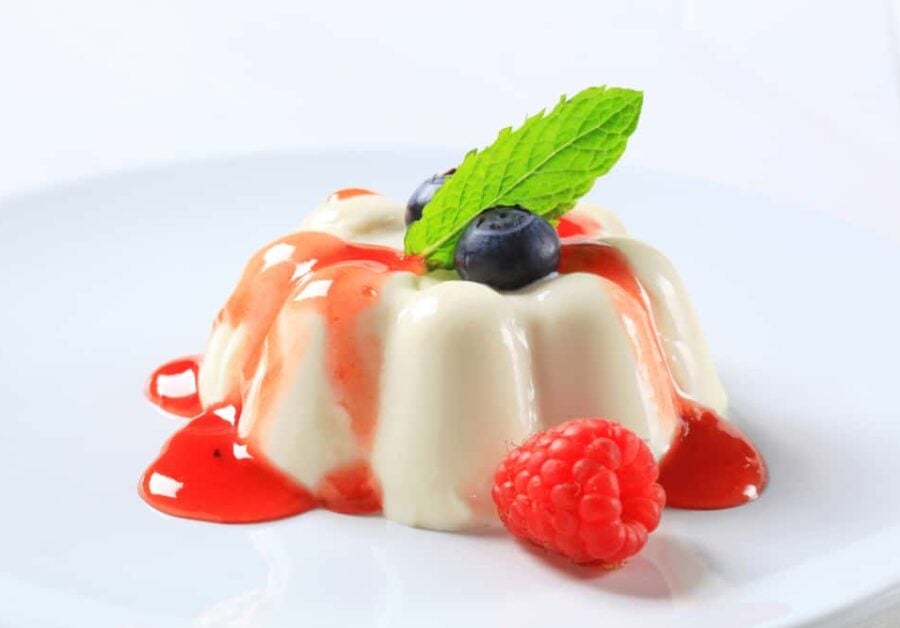As a dessert, panna cotta is a real crowd pleaser and why wouldn’t it be?
Aside from being simple to make, there’s an almost unlimited variety of flavors with which to experiment.
For all those reasons and more, it’s no wonder that panna cotta is a dessert you’d be happy to make for yourself or for a get together with family and friends.
So we know it’s delicious and easy to whip up but why might you want to freeze it?
Well, there are a couple of reasons.
The first is to help the panna cotta set more quickly, and the second is when you want to save some of your batch to eat later on or perhaps they’re leftovers or something you planned to do on purpose.
Either way, the short answer is yes, you can freeze panna cotta to set it more quickly or to eat it at a later date. When setting it, you’ll only need to keep it in the freezer for about a half an hour and for longer periods, panna cotta can be frozen for up a month.
We’ll talk about both situations in more detail but first we’ll talk about the one ingredient in panna cotta that makes things a little tricky – gelatin.
Gelatin Is the Variable in Freezing Panna Cotta
Gelatin is truly a magical ingredient.
After it’s dissolved in liquid, it has a chameleon-like ability to assume the flavors of the mixture. But the best part where panna cotta is concerned is the silky smooth mouthfeel it gives to the dessert once it’s cooled. Since that creaminess is the allure of panna cotta, leaving gelatin out of the equation is not an option.
While there are a couple of substitutes you can try, they too have limitations when it comes to freezing but we’ll touch on those a bit later.
For now, back to gelatin.
Gelatin is a protein which is derived from animal tissue collagen, usually pigs. Collagen is vital to the structural integrity of muscles and tendons and ensures their strength, resiliency, and elasticity. To extract the collagen, pig skin is soaked in an acid mix that breaks the protein bonds in the collagen. After this is complete, what remains goes through a process of filtration, purification and drying, which turns it into the powdered form we all know.
Gelatin is unique in that it’s the only protein that can add thickness to liquids. While other thickening agents like starches and flours turn creamy, gelatin remains clear as it solidifies, making it ideal for a wide variety of Panna Cotta flavors.
When gelatin is prepared for use in panna cotta, it forms a bond between water molecules which is what gives panna cotta its wobbly texture. But if frozen for an extended period, the water molecules in gelatin will break the bonds that they formed and will not reform them as thawing occurs.
The good news is that panna cotta also uses cream, which freezes very well. The trick is to find the right balance between freezing and thawing times so that you can preserve the delicate smoothness that makes panna cotta what it is.
How Long Does Panna Cotta Take To Set In the Freezer?
Once your panna cotta is placed in the freezer, it can take up to 30 minutes for it to set. It’s generally not recommended to go much longer than that if you plan on serving your dessert right away.
How Long Can You Keep Panna Cotta in the Refrigerator?
For fresh panna cotta, it’s best to eat it within 48 hours if leaving the dessert uncovered. However, if properly wrapped to prevent the absorption of other odors in the fridge, this time can be extended from 7 to 10 days.
How Long Can You Freeze Panna Cotta?
As previously mentioned, panna cotta can be frozen and keep quite well for about a month or even longer if kept tightly sealed to protect it from absorbing any unwanted odors in your freezer.
Thawing Frozen Panna Cotta
After removing the panna cotta from the freezer, it’s best not to defrost it at room temperature but instead, place it in the refrigerator.
The reason for this is that under the right circumstances, it’s possible that the cream used in the panna cotta can split. While this can ruin the visual appeal of your dessert, it’s still fine to eat it.
Defrosting at room temperature increases the likelihood of the cream splitting and in rare cases, it’s even possible that the cream can go bad so when in doubt, thawing in the fridge is an excellent idea.
Gelatin Substitute for Panna Cotta
Alternative panna cotta recipes with gelatin substitutes like agar agar and cornstarch do not freeze well either for reasons of their own.
While it is possible to set recipes with agar agar and cornstarch, it’s not a good idea to freeze either of them.
Agar agar is most commonly used by those who don’t consume meat products as an alternative to gelatin. While it can work well as a gel substitute in fresh panna cotta, freezing agar agar causes a cascade of events that results in a change to the gel’s texture and also causes loss of water.
As for cornstarch, it too can be a reasonable substitute for gelatin in panna cotta but it’s not a good idea to freeze it. After it’s been frozen, cornstarch has a tendency to develop a sponge like texture with is not what you want with the creaminess of panna cotta.

Hey there, I’m Melody! I’m a lifelong foodie and love talking about it to anyone who’s willing to listen (or read!) about my opinions. My favorite pastimes include cooking, eating my cooking and thinking about what I’m going to make next!

